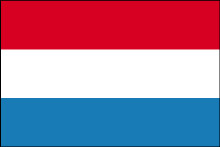Luxembourg at a glance
Country
Territory
Population
Economy
Employment
New information and communication technology
Transport
Climate
The Luxembourg national flag
Luxembourg at a glance
| Official name |
Grand Duchy of Luxembourg |
| National holiday |
23 June |
| National language |
Luxembourgish ("Lëtzebuergesch") |
| Administrative languages |
French, German and Luxembourgish |
| Type of government |
Constitutional monarchy under a system of parliamentary democracy |
| Head of State |
HRH Grand Duke Henri |
| Head of Government |
Prime Minister Jean-Claude Juncker |
| Minister for Foreign Affairs |
Jean Asselborn |
| Political parties in the government |
Coalition between the Christian Social Party (PCS) and the Luxembourg Socialist Workers’ Party (POSL) |
| Political parties represented in the Chamber of Deputies |
Christian Social Party (PCS, 24 seats), Luxembourg Socialist Workers’ Party (POSL, 14 seats), Luxembourg Democratic Party (PDL, 10 seats), Green Party (Déi Gréng, 7 seats), Action Committee for Democracy and Justice (ADR, 5 seats). Total: 60 Members of Parliament |
| Number of Members of the European Parliament from Luxembourg |
6 (3 from PCS, 1 from POSL, 1 from PDL and 1 form the Green Party Déi Gréng) |
Country
| Capital |
Luxembourg |
| Administrative divisions |
3 districts (Luxembourg, Diekirch and Grevenmacher) |
| Cantons |
12 cantons |
| Local town council areas |
118 local town council areas (communes) |
| Electoral constituencies |
4 electoral constituencies (north, south, east and centre) |
| Largest communes |
Luxembourg (77,300 inhabitants), Esch-sur-Alzette (27,900 inhabitants), Differdange (18,900 inhabitants) |
| Natural regions |
Oesling in the north (32% of the territory), Gutland in the south (68% of the territory) |
Territory
| Area |
2,586km² |
| Developed area |
8.4% |
| Size |
82km from north to south, 57km from west to east |
| Neighbouring countries |
Belgium, France and Germany |
| Highest point |
560m (Wilwerdange) |
| Lowest point |
130m (Wasserbillig) |
Population
| Total population |
451,600 (figures for 2004, source: STATEC) |
|
- of which: Luxembourg nationals: 277,400 (61.42%)
- foreign residents: 174,200 (38.6%)
-
- of which: Portuguese residents: 63,760 (14.1% of the total population)
- French residents: 21,880 (4.8% of the total population)
- Italian residents: 18,890 (4.1% of the total population)
- Belgian residents: 16,040 (3.5% of the total population)
|
| Density |
Population density: 173 inhabitants/km² (figures for 2004, source: STATEC) |
| Active population |
67.1% (figures for 2004, source: STATEC) |
| Life expectancy at birth |
74 for men, 81 for women (figures for 2000/2002, source: STATEC) |
| Fertility rate |
1.63 children born per woman (figures for 2003, source: STATEC) |
| Birth rate (number of births per 1,000 inhabitants) |
11.8 (figures for 2003, source: STATEC) |
Economy (figures for 2003, source: STATEC)
| Currency |
euro |
| Gross Domestic Product (GDP) |
EUR 23.5 billion |
| GDP per capita |
EUR 52,600 |
| GDP growth rate |
2.1% |
| Exports |
EUR 9.9 billion |
| Imports |
EUR 12.6 billion |
| Current balance |
EUR 2,188 million |
| Inflation rate |
2.3% |
Employment
| National labour force |
301,569 people (source: Luxembourg Central Bank) |
| Cross-border workers |
106,900 (figures for 2003, source: STATEC) |
| Unemployment rate |
4.2% (source: Economic Committee, October 2004) |
| Employment rate |
61% (figures for 2003, source: STATEC) |
| Number of banks |
169 (figures for 2003, source: STATEC) |
| Number of registered companies |
26,243 (figures for 2003, source: STATEC) |
|
- of which: 2,450 in the agriculture and wine-producing industry (9.33%)
- 12 in the non-energy extractive industry (0.04%)
- 964 in the manufacturing industry (3.67%)
-
57 in the energy and water industries (0.21%)
-
1,952 in the construction industry (7.43%)
-
20,808 in the commercial services industry (79.23%)
|
New information and communication technology
| Households with a computer |
74% (figures for 2003, source: STATEC) |
| Households connected to the Internet |
62% (figures for 2003, source: STATEC) |
| Businesses connected to the Internet |
97% (figures for 2003, source: STATEC) |
| Number of Luxembourg websites online |
approx. 19,000 (source: Restena) |
Transport
| National road network |
2,876 km (figures for 2003, source: STATEC) |
| Total number of vehicles |
358,499 (figures for 2004, source: STATEC) |
| Railway lines in use |
275 km (figures for 2003, source: STATEC) |
| Number of passengers who used Luxembourg airport in 2003 |
1,458,000 (source: STATEC) |
Climate
| Average annual rainfall |
782.2mm |
| Average temperature in January |
0.8°C |
| Average temperature in July |
17.5°C |
The Luxembourg national flag
|
The Law of 27 July 1993 authorises the Grand Duke to formulate the precise colour combination of the national flag. The colours are defined in accordance with the international standards in force.
To distinguish the Luxembourg flag (three horizontal red, white and blue stripes) from the Dutch flag, a practical solution has been adopted: the blue on the Dutch flag is ultramarine while that on the Luxembourg flag is sky blue (Pantone colour standard No. 299C). The red corresponds to Pantone colour standard No. 032C.
|

|

